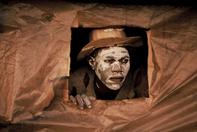Initiation Practices
Some 150 years ago or more, all southern African chiefdoms and Khoi-san peoples observed initiation practices to prepare the youth, male and female, for their future roles in adult society.

At some unknown date in the past, the Xhosa chiefdom adopted circumcision as the principal form of male initiation, possibly from a Sotho source, and it has become closely associated with them ever since. In the course of time and largely as a result of Xhosa influence, circumcision was adopted by neighbouring chiefdoms such as the Thembu, Mfengu, Bomvana, Xesibe, Mpondo and Mpondomise.
Undoubtedly, circumcision originally had a militaristic significance, as a worthy ordeal for the young men who were to serve as warriors before being eligible to marry. When Dingiswayo, Shaka's predecessor, introduced the regimental system in Zululand, Zulu circumcision was discontinued.
The Xhosa Initiate

In the past, every Xhosa initiate was presented with spears and war clubs by his father and father's brothers at the coming-out ceremony 'umgidi' held to incorporate the initiates 'abakhwetha' back into society from the bush where they had been secluded.
Circumcision continues to be practised in attenuated form by Xhosa-speakers, both in towns and rural areas, although its efficacy is presently questionable from a medical point of view. Since the early 1990s, the numbers of male initiates who suffer medical and psychiatric complications, and even die, as a result of the circumcision operation has been increasing every year. The solution to these vexing problems obviously lies in placing the circumcision operation itself in the hands of medically trained personnel.